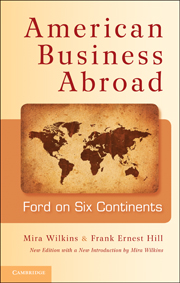Book contents
- Frontmatter
- Contents
- List of Illustrations
- Preface
- Introduction to the New Edition
- Introduction to the First Edition
- 1 First Venture
- 2 Probing for Markets
- 3 Model T: Triumph and Fable
- 4 The Alchemy of War
- 5 Steps in Expansion
- 6 The Sun Never Sets
- 7 Prosperity and Frustration
- 8 The Missionary Spirit
- 9 The Best-Laid Plans
- 10 Marriage of Convenience
- 11 Time of Desperation
- 12 A World Disturbed
- 13 Extreme of Nationalism
- 14 The British Empery
- 15 On Both Sides of World War II
- 16 The Crippled Phoenix
- 17 The New Company
- 18 Manufacturing for World Markets: From Dagenham to Geelong
- 19 New Times, New Faces, New Policies
- Appendices
- Bibliographical Essay
- Notes
- Index
- Titles in the series
- Plate section
17 - The New Company
Published online by Cambridge University Press: 05 June 2012
- Frontmatter
- Contents
- List of Illustrations
- Preface
- Introduction to the New Edition
- Introduction to the First Edition
- 1 First Venture
- 2 Probing for Markets
- 3 Model T: Triumph and Fable
- 4 The Alchemy of War
- 5 Steps in Expansion
- 6 The Sun Never Sets
- 7 Prosperity and Frustration
- 8 The Missionary Spirit
- 9 The Best-Laid Plans
- 10 Marriage of Convenience
- 11 Time of Desperation
- 12 A World Disturbed
- 13 Extreme of Nationalism
- 14 The British Empery
- 15 On Both Sides of World War II
- 16 The Crippled Phoenix
- 17 The New Company
- 18 Manufacturing for World Markets: From Dagenham to Geelong
- 19 New Times, New Faces, New Policies
- Appendices
- Bibliographical Essay
- Notes
- Index
- Titles in the series
- Plate section
Summary
“We have come to the International Division late in the problems of the Ford Motor Company,” declared Henry Ford II in 1948, “so you haven't seen anything yet of the changes we want to accomplish.” From 1945 to 1948 the young president had miraculously transformed the company. Shrewd modern management had replaced the disorganization of 1945. Costs of production had been steadily lowered, improved manufacturing techniques introduced, and a range of new products engineered and styled. After suffering a loss in 1946, in 1947 the company showed a profit before taxes of $108.5 million. The wholly unsatisfactory relationship with Harry Ferguson had been severed. If the company still ranked third in the American automobile industry, following General Motors and Chrysler, its rapid rise to second place seemed inevitable. Henry Ford II was now prepared to consider the vast overseas operations of his firm, and turned first to Europe, where operations were largest in volume and most profitable.
Early in 1948 Europe had yet to recover from the shock and ravages of war. Reconstruction dragged along, quickly absorbing funds without seeming to gain much strength; and after extensive appropriations by the United States, Secretary of State George C. Marshall in June 1947 had outlined a European Recovery Plan directed “against hunger, poverty, desperation, and chaos.” The early months of 1948 found the American Congress debating this plan and other possibilities for foreign aid.
- Type
- Chapter
- Information
- American Business AbroadFord on Six Continents, pp. 360 - 379Publisher: Cambridge University PressPrint publication year: 2011

